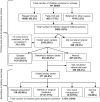Visual impairment and refractive errors in school children in Andhra Pradesh, India
- PMID: 35647998
- PMCID: PMC9359223
- DOI: 10.4103/ijo.IJO_2949_21
Visual impairment and refractive errors in school children in Andhra Pradesh, India
Abstract
Purpose: Addressing childhood vision impairment (VI) is one of the main goals of the World Health Organization's (WHO) combating blindness strategies. The primary aim of this study was to estimate the prevalence of VI, causes, and its risk factors in school children in Krishna district, Andhra Pradesh, India.
Methods: Children aged 4-15 years were screened in schools using the 6/12 Snellen optotype by trained community eye health workers, and those who failed the test and those reported or found to have obvious eye conditions were referred to primary (VC), secondary (SC), or tertiary (TC) care centre appropriately, where they underwent a complete eye examination including cycloplegic refraction and fundus examination.
Results: A total of 56,988 children were screened, of whom 51.18% were boys. The mean age was 9.69 ± 3.26 years (4-15 years). Overall, 2,802/56,988 (4.92%) children were referred to a VC, of which 632/56,988 (1.11%) required referral to SC/TC. PVA of <6/12 was found in 1.72% (95% confidence interval [CI]: 1.61-1.83). The prevalence of refractive error (corrected and uncorrected) was 2.38% (95% CI: 2.26-2.51) and myopia was 2.17% (95% CI: 2.05-2.29). In multivariable analysis, older children, those in urban schools, private schools, and children with a disability had an increased risk of VI and myopia. Additionally, the risk of myopia was higher among girls than boys. Of those referred and reached SC/TC, 73.64% were due to avoidable causes.
Conclusion: Childhood VI prevalence was 1.72% in this region. Uncorrected refractive error (URE) was the major cause of VI in children. Older age, schools in urban locations, private schools, and the presence of disability were associated with the risk of VI among children.
Keywords: Childhood blindness; childhood vision impairment; prevalence; refractive error; risk factors.
Conflict of interest statement
None
Figures
Comment in
-
Commentary: Screening the future generation: A path to better future.Indian J Ophthalmol. 2022 Jun;70(6):2139-2140. doi: 10.4103/ijo.IJO_758_22. Indian J Ophthalmol. 2022. PMID: 35647999 Free PMC article. No abstract available.
References
-
- Razavi H, Kuper H, Rezvan F, Amelie K, Mahboobi-Pur H, Oladi MR, et al. Prevalence and causes of severe visual impairment and blindness among children in the lorestan province of iran, using the key informant method. Ophthalmic Epidemiol. 2010;17:95–102. - PubMed
-
- Kalua K, Patel D, Muhit M, Courtright P. Causes of blindness among children identified through village key informants in Malawi. Can J Ophthalmol. 2008;43:425–7. - PubMed
MeSH terms
LinkOut - more resources
Full Text Sources
Medical
Miscellaneous



